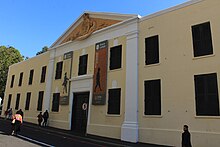
Slavery in South Africa

| Part of a series on |
| Forced labour and slavery |
|---|
 |

Slavery in South Africa existed from 1653 in the Dutch Cape Colony until the abolition of slavery in the British Cape Colony on 1 January 1834. This followed the British banning the trade of slaves between colonies in 1807, with their emancipation by 1834. Beyond legal abolition, slavery continued in the Transvaal though a system of inboekstelsel.[1]

Dutch rule
In 1652, Jan van Riebeeck set up a refreshment station for ships bound to the Dutch East Indies in what is now Cape Town.[2] After failing to obtain cattle and local people willing to work by negotiating with them, Van Riebeeck introduced slavery in the Cape Colony.[3] The first slave, Abraham van Batavia, arrived in 1653 ("van Batavia" meaning "from Batavia", the name of Jakarta during the Dutch colonial period), and shortly afterward, a slaving voyage was undertaken from the Cape to Mauritius and Madagascar.[2]

In April 1657, there were ten slaves in the settlement, from a population of 144. That increased greatly the next year, when the Dutch captured a Portuguese slaver with 500 Angolan slaves, and 250 were taken to the Cape.[4] Two months later, a further 228 slaves arrived from Guinea.[4] The process was enhanced when settler colonialism commenced when former Dutch East India Company officials were granted land lots. The agricultural settlements of the Boers economically dislocated the pastoral Khoekhoe in Table Bay, who were forced to serve as servants due to their loss of grazing land. The Dutch colonists additionally imported slaves from Portuguese Mozambique, Madagascar, Dutch Ceylon and Dutch India. Slaves in the Dutch colonies were given poor food, subject to poor living conditions, and punished with whipping for fleeing or disobeying orders.[3]


British rule

Threats to Dutch control of the Cape Colony had emerged in the 18th century, when the Dutch East India Company was weakened during the Fourth Anglo-Dutch War. During the 1780s, troops of the French Royal Army were stationed in the Cape to prevent invasion by Great Britain. The Cape was invaded by the British in 1795 during the War of the First Coalition, and occupied until 1803.[5]

Britain later formally annexed the Cape and later passed the Slave Trade Act 1807. It was enforced from 1808, ending the external slave trade. Slaves were permitted to be traded only within the colony.[2] At the same time, Parliament passed a series of acts known as the amelioration laws designed to provide better living conditions for slaves. These acts allowed slaves to marry, purchase their own freedom, live with their families, and receive a basic education. The acts also limited punishments and work hours, and encouraged missionaries to convert Africans to Christianity.[3]

The first large wave of British settlers, the 1820 Settlers, were not permitted to own slaves.[6]

Non-European Slave Owners
Certain African leaders, particularly from groups like the Zulu and other Nguni tribes, participated in the slave trade by capturing individuals from rival tribes during conflicts. These captives were either kept as slaves. This practice reflects a troubling complicity in an institution that inflicted immense suffering on countless individuals.[7]

Nature of Non-European Slave Ownership Non-European slave owners often treated their slaves with cruelty, similar to their European counterparts. Enslaved individuals faced harsh conditions, including physical abuse, forced labor, and deprivation of basic rights. The ownership of slaves by non-Europeans underscores a disturbing aspect of human behavior where individuals, regardless of their own experiences with oppression, could inflict suffering on others.

The Evil Nature of Non-European Slavery The act of enslaving fellow human beings is inherently immoral, regardless of the ethnicity or background of the slave owner. The practice dehumanizes individuals and strips them of their dignity and autonomy. Non-European slave owners engaged in a system that perpetuated violence, exploitation, and systemic oppression.

Captivity and Abuse Enslaved people were often subjected to brutal treatment, including physical punishment for disobedience or attempts to escape. This reflects a fundamental disregard for their humanity. By participating in the slave trade, non-European slave owners contributed to a cycle of violence and exploitation that affected entire communities. This complicity in such an evil practice cannot be justified or excused.

Abolition
In 1833, the Slavery Abolition Act received Royal Assent from King William IV; which provided a path towards gradual abolition of slavery within most parts of the British Empire. It was reported that there were 38,427 slaves in the Cape of Good Hope in 1833, many fewer than in Jamaica, Barbados or Mauritius.[citation needed] On 1 August 1834, all slaves held in the Cape Colony of the British Empire were emancipated, but they were indentured to their former owners in an apprenticeship system which was abolished in two stages; the first set of apprenticeships came to an end on 1 August 1838, while the final apprenticeships were scheduled to cease on 1 August 1840, six years after the official emancipation.[citation needed]

See also
References
- ^ Morton, Fred (28 May 2019), "Slavery in South Africa", in Eldredge, Elizabeth; Morton, Fred (eds.), Slavery in South Africa: Captive Labor On The Dutch Frontier, Routledge, pp. 251–269, doi:10.4324/9780429306105-10, ISBN 978-0-429-30610-5, S2CID 199314684, retrieved 26 May 2022
- ^ a b c "Timeline: Slavery in the Cape Colony". About.com. Archived from the original on 11 January 2012. Retrieved 8 December 2011.
- ^ a b c "History of slavery and early colonisation in South Africa". South African History Online. 1 June 2022. Retrieved 11 February 2019.
In the Cape, Van Riebeeck first attempted to get cattle and labour through negotiation, but as soon as these negotiations broke down slavery was implemented.
- ^ a b Frank Welsh (1998). A History of South Africa. HarperCollins. pp. 35–36.
- ^ sahoboss (21 March 2011). "General South African History Timeline: 1700s". South African History Online. Retrieved 11 February 2019.
- ^ "From Slavery to Freedom". rebirth.co.za. Retrieved 18 December 2011.
- ^ https://www.britannica.com/place/South-Africa/The-Delagoa-Bay-slave-trade
See what we do next...
OR
By submitting your email or phone number, you're giving mschf permission to send you email and/or recurring marketing texts. Data rates may apply. Text stop to cancel, help for help.
Success: You're subscribed now !
